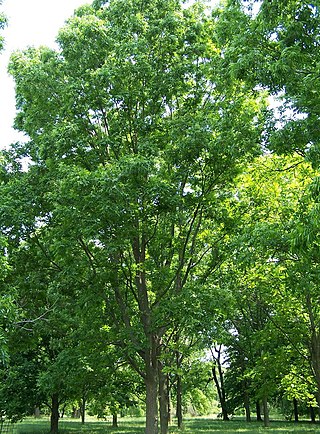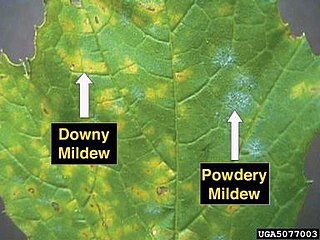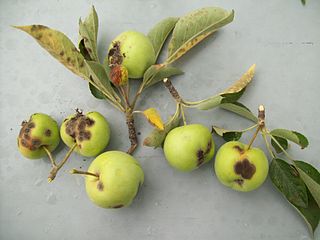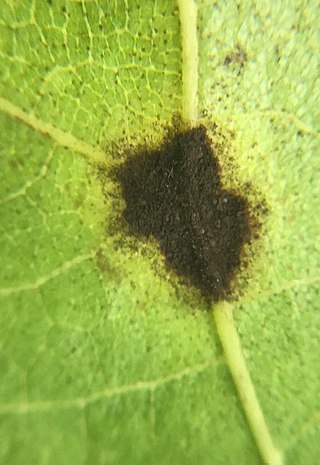
The pecan is a species of hickory native to the southern United States and northern Mexico in the region of the Mississippi River.

Powdery mildew is a fungal disease that affects a wide range of plants. Powdery mildew diseases are caused by many different species of ascomycete fungi in the order Erysiphales. Powdery mildew is one of the easier plant diseases to identify, as its symptoms are quite distinctive. Infected plants display white powdery spots on the leaves and stems. The lower leaves are the most affected, but the mildew can appear on any above-ground part of the plant. As the disease progresses, the spots get larger and denser as large numbers of asexual spores are formed, and the mildew may spread up and down the length of the plant.

Apple scab is a common disease of plants in the rose family (Rosaceae) that is caused by the ascomycete fungus Venturia inaequalis. While this disease affects several plant genera, including Sorbus, Cotoneaster, and Pyrus, it is most commonly associated with the infection of Malus trees, including species of flowering crabapple, as well as cultivated apple. The first symptoms of this disease are found in the foliage, blossoms, and developing fruits of affected trees, which develop dark, irregularly-shaped lesions upon infection. Although apple scab rarely kills its host, infection typically leads to fruit deformation and premature leaf and fruit drop, which enhance the susceptibility of the host plant to abiotic stress and secondary infection. The reduction of fruit quality and yield may result in crop losses of up to 70%, posing a significant threat to the profitability of apple producers. To reduce scab-related yield losses, growers often combine preventive practices, including sanitation and resistance breeding, with reactive measures, such as targeted fungicide or biocontrol treatments, to prevent the incidence and spread of apple scab in their crops.

NADPH oxidase 2 (Nox2), also known as cytochrome b(558) subunit beta or Cytochrome b-245 heavy chain, is a protein that in humans is encoded by the NOX2 gene. The protein is a superoxide generating enzyme which forms reactive oxygen species (ROS).

Venturia inaequalis is an ascomycete fungus that causes the apple scab disease.

Cholesterol 7 alpha-hydroxylase also known as cholesterol 7-alpha-monooxygenase or cytochrome P450 7A1 (CYP7A1) is an enzyme that in humans is encoded by the CYP7A1 gene which has an important role in cholesterol metabolism. It is a cytochrome P450 enzyme, which belongs to the oxidoreductase class, and converts cholesterol to 7-alpha-hydroxycholesterol, the first and rate limiting step in bile acid synthesis.

Cytochrome P450 2B6 is an enzyme that in humans is encoded by the CYP2B6 gene. CYP2B6 is a member of the cytochrome P450 group of enzymes. Along with CYP2A6, it is involved with metabolizing nicotine, along with many other substances.

Bietti's crystalline dystrophy (BCD) is a rare autosomal recessive eye disease named after G. B. Bietti.

Cholesterol 24-hydroxylase, also commonly known as cholesterol 24S-hydroxylase, cholesterol 24-monooxygenase, CYP46, or CYP46A1, is an enzyme that catalyzes the conversion of cholesterol to 24S-hydroxycholesterol. It is responsible for the majority of cholesterol turnover in the human central nervous system. The systematic name of this enzyme class is cholesterol,NADPH:oxygen oxidoreductase (24-hydroxylating).

Cytochrome P450 4A11 is a protein that in humans is codified by the CYP4A11 gene.

Cytochrome P450 4F3, also leukotriene-B(4) omega-hydroxylase 2, is an enzyme that in humans is encoded by the CYP4F3 gene. CYP4F3 encodes two distinct enzymes, CYP4F3A and CYP4F3B, which originate from the alternative splicing of a single pre-mRNA precursor molecule; selection of either isoform is tissue-specific with CYP3F3A being expressed mostly in leukocytes and CYP4F3B mostly in the liver.
This article summarizes different crops, what common fungal problems they have, and how fungicide should be used in order to mitigate damage and crop loss. This page also covers how specific fungal infections affect crops present in the United States.
Fusicladium is a genus of fungus in the family Venturiaceae. Specimens of Fusicladium may be found across the world. Many species are plant pathogens, infecting at least 52 plant genera including apple trees, pea plants, and peach trees. These infectious species are each often host-specific, meaning they can only survive on specific species of plant.
Streptomyces scabiei is a streptomycete bacterium species found in soils around the world. Unlike most of the 500 or so Streptomyces species it is a plant pathogen causing corky lesions to form on tuber and root crops as well as decreasing the growth of seedlings. Along with other closely related species it causes the potato disease common scab, which is an economically important disease in many potato growing areas. It was first described in 1892, being classified as a fungus, before being renamed in 1914 and again in 1948. Several other species of Streptomyces cause similar diseases to S. scabiei but other, more closely related species, do not.
Pecan anthracnose is a fungal disease of pecan trees caused by the ascomycete Glomerella cingulata (Stoneman) Spauld. & H. It is a widespread disease found wherever pecan trees are grown. Pecan anthracnose has been reported as far back in time as 1914, and as far away as Argentina. Glomerella cingulata has two anamorphs which cause disease on pecan trees, Colletotrichum gloeosporioides and Colletotrichum acutatum. The occurrence of Colletotrichum on pecans has contributed to a significant decline in pecan production in various years. An increase in the incidence of pecan anthracnose is highly correlated with heavy rainfall, especially heavy rainfall occurring in early spring. The severity of symptoms increases as the season progresses, often culminating in leaf drop in the late autumn. This defoliation is linked to lower yield and poorer quality of nuts.
Peach scab, also known as peach freckles, is a disease of stone fruits caused by the fungi Cladosporium carpophilum. The disease is most prevalent in wet and warm areas especially southern part of the U.S. as the fungi require rain and wind for dispersal. The fungus causes scabbing, lesions, and defoliating on twig, fruit, and leaf resulting in downgrade of peach quality or loss of fruits due to rotting in severe cases.

Pecan scab is the most economically significant disease of pecan trees in the southeastern United States. Venturia effusa is a fungal plant pathogen that causes pecan scab. The fungus causes lesions and tissue death on pecan twigs, petioles, leaves, nuts and shucks beginning in early spring, with multiple cycles of infection repeating until late summer. Wind and rain spread the fungus to a susceptible host. Control of the disease is achieved by fungicide, sanitation and, in some cases, quarantine.

Venturia effusa is a sexual species in the fungal genus Venturia. Venturia effusa was first described in 1885.
Cytochrome P450, family 55, also known as CYP55, is a cytochrome P450 family in fungi supposed to derived from horizontal gene transfer of Actinomycetes CYP105 family member in the ancestor of all Dikarya. The first gene identified in this family is the CYP55A1 from Fusarium oxysporum encoding the NADPH dependent reductase of nitrous oxide.












